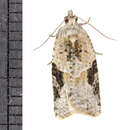fr
noms dans le fil d’Ariane


Argyrotaenia mariana, the gray-banded leafroller moth, is a species of moth of the family Tortricidae. It is found in North America, where it has been recorded from Connecticut, Florida, Georgia, Illinois, Indiana, Kentucky, Maine, Maryland, Massachusetts, New Brunswick, New Hampshire, New York, North Carolina, Ohio, Ontario, Pennsylvania, Quebec, Tennessee and West Virginia.[2]
The wingspan is about 20 mm. The ground colour of the forewings is pale yellowish or whitish with a large dark grey patch and a greenish-yellow band.[3] Adults have been recorded on wing from March to August.
The larvae feed on Acer species, Prenanthes species (including Prenanthes trifoliata) Alnus species, Betula species (including Betula alleghaniensis, Betula papyrifera, Betula populifolia), Viburnum species, Kalmia angustifolia, Vaccinium species (including Vaccinium uliginosum), Quercus species, Malus species (including Malus pumila, Malus sylvestris), Prunus virginiana, Pyrus species, Populus tremuloides, Salix species and Ulmus americana.[4]
Argyrotaenia mariana, the gray-banded leafroller moth, is a species of moth of the family Tortricidae. It is found in North America, where it has been recorded from Connecticut, Florida, Georgia, Illinois, Indiana, Kentucky, Maine, Maryland, Massachusetts, New Brunswick, New Hampshire, New York, North Carolina, Ohio, Ontario, Pennsylvania, Quebec, Tennessee and West Virginia.
The wingspan is about 20 mm. The ground colour of the forewings is pale yellowish or whitish with a large dark grey patch and a greenish-yellow band. Adults have been recorded on wing from March to August.
The larvae feed on Acer species, Prenanthes species (including Prenanthes trifoliata) Alnus species, Betula species (including Betula alleghaniensis, Betula papyrifera, Betula populifolia), Viburnum species, Kalmia angustifolia, Vaccinium species (including Vaccinium uliginosum), Quercus species, Malus species (including Malus pumila, Malus sylvestris), Prunus virginiana, Pyrus species, Populus tremuloides, Salix species and Ulmus americana.
Argyrotaenia mariana is een vlinder uit de familie van de bladrollers (Tortricidae).[1] De wetenschappelijke naam van de soort is voor het eerst geldig gepubliceerd in 1882 door Fernald.
Bronnen, noten en/of referenties